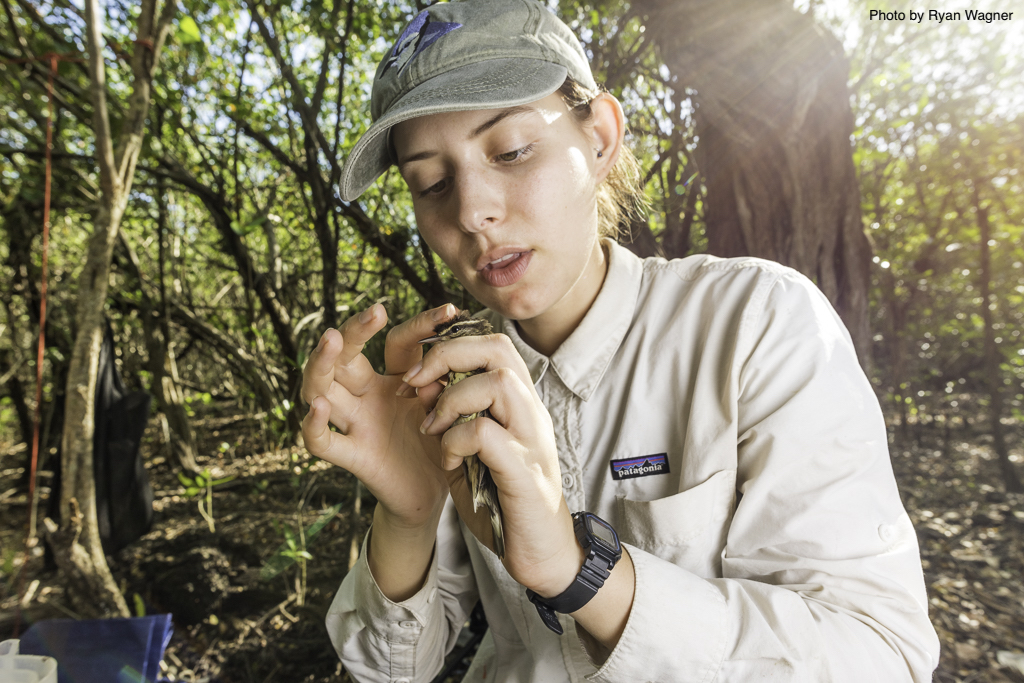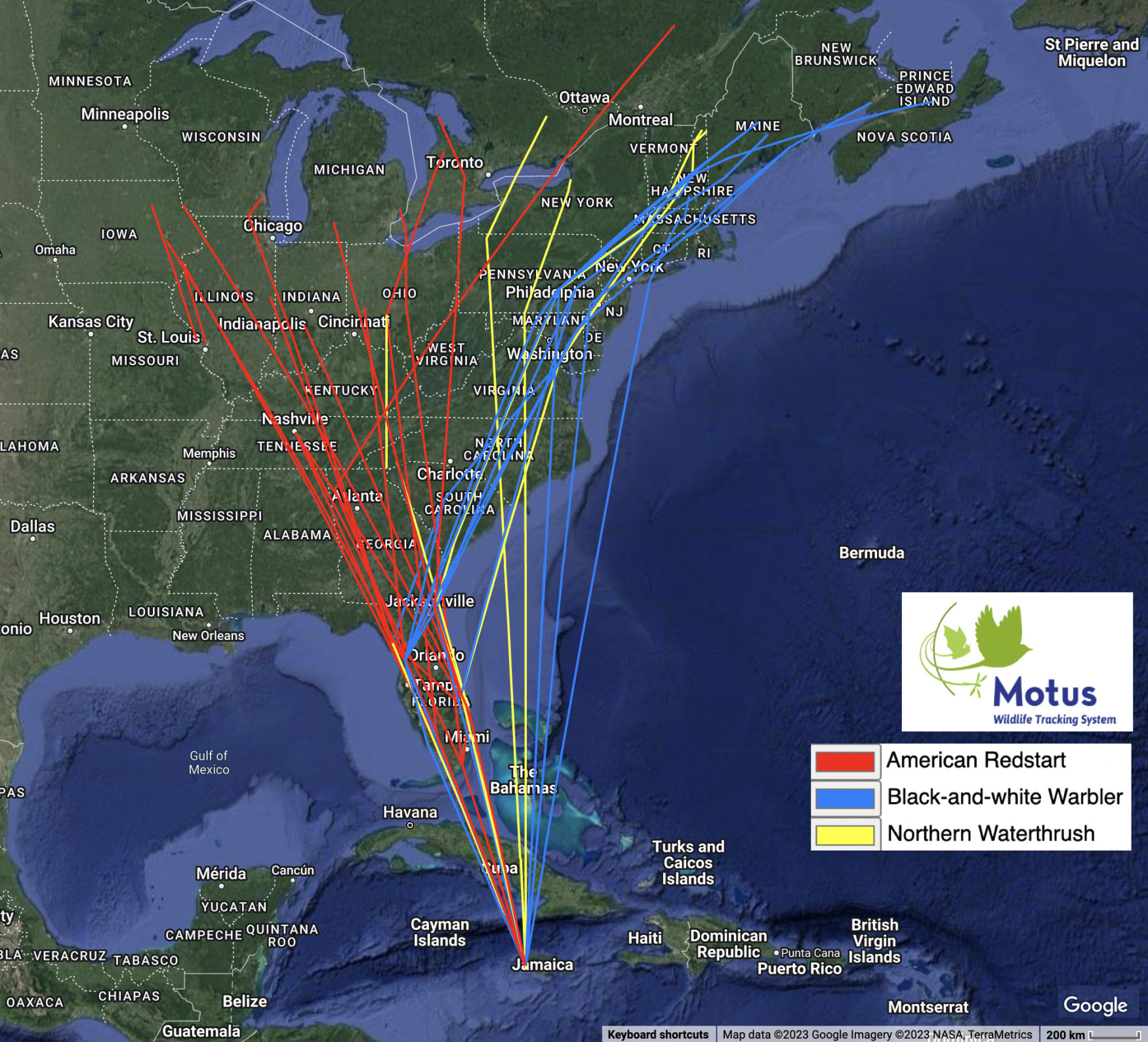
A bird in the hand provides great data – TRU Newsroom
Photo by Ryan Wagner
Each year, songbirds migrate thousands of kilometres from their breeding grounds in Canada and the United States to spend the winter in the neotropical Caribbean, and climate change is threatening their ability to survive the journey.
A Thompson Rivers University (TRU) grad student is working to fill critical gaps in understanding the annual life cycles of songbirds. Shae Turner, a master of science student in environmental science, is using radio transmitter tags and an international collaborative tracking network, the Motus Wildlife Tracking System (Motus), to study the overwintering and migration ecology of migratory songbirds under the supervision of Dr. Matthew Reudink.
“The Caribbean is becoming increasingly drier due to global climate change. This change has consequences for the success of our migratory birds, making it more important than ever to understand the part of their lives that they spend in the winter,” says Turner.
Collecting data in the field
For over 30 years, Font Hill Nature Reserve in southwestern Jamaica has been a hub for researchers studying migratory bird ecology. Turner spent January through April at the reserve, conducting field research for her master’s thesis with colleagues and researchers from other international institutions. The study elevates TRU as an important Canadian research university for bird ecology as part of a collaborative effort with American research institutions like Ohio State University and Georgetown University.
Photo by Ryan Wagner
“The overwintering period is one of the least studied periods of the annual cycle,” she says. “Yet, understanding the conditions experienced by migratory birds during winter and how these conditions can carry over to shape success during spring migration and the breeding season is crucial for understanding species’ declines.”
Turner safely captured songbirds using a mist-netting technique, then applied uniquely numbered aluminum bands for individual identification. The researchers collected measurements such as body mass and wing length, and applied small (weighing less than 0.3 g) radio tags to the birds’ backs.
Additionally, as part of the fieldwork for this research, Turner and colleagues mentored a Jamaican field technician in developing ornithological field skills, including identifying, safely capturing and banding birds; collecting biometric measurements and transcribing banding data.
“As the birds departed Jamaica in the spring and travelled up the east coast or through the mid-western USA, their tags were recorded by a global array of automated towers. Some of these birds travelled as far as Nova Scotia, Ontario, and Quebec for the breeding season,” she says.
Tracking technology is crucial
With the support of Reudink and her advisory committee, Turner is currently analyzing the data from her time in Jamaica to determine how much environmental conditions affected the birds’ moult — when birds shed and grow new feathers, which determines spring migration timing.
“Despite the fact that migratory birds spend a majority of their lives in the tropics, we are only now recognizing just how important this wintering period can be in shaping the lives of migratory birds,” says Reudink.
“By applying cutting-edge tracking technology (Motus tags) and other advanced analytical techniques to fundamental questions about the biology of overwintering migratory birds, Shae’s work is poised to make a large impact. Simply understanding the patterns of feather replacement in wintering birds is a major gap in our knowledge, and her work goes well beyond by understanding the causes and consequences of moult timing — all of which may carry over to influence survival, migration and breeding throughout the rest of the year.”
Each spring, the arrival of colourful migratory songbirds sparks joy in Canadians, inspiring many to connect with nature.
“Necessary for the effective conservation of migratory species is an understanding of their full annual life cycles. Not only are songbirds indicators of our environment’s health, but they also provide valuable ecosystem services such as insect control,” says Turner.
Honourable mention for her work
Her work recently received international recognition when she presented preliminary results at the American Ornithological Society and Society of Canadian Ornithologists Joint Conference in London, Ont., in August. Her poster presentation was awarded an American Ornithological Society Council Presentation honourable mention for a notable presentation in ornithology.
While this research is limited to six focal species of birds, the research system can be used as a model for researchers exploring these carry over effects in other species that moult during winter.
Beyond Turner’s master’s thesis, the results of this study will have long-term impacts through contributions to the publicly accessible Motus Wildlife Tracking System database, a database building a global picture of when and where birds migrate, as well as long-term, site-specific datasets for Font Hill Nature Reserve, which has been instrumental to scientific understanding of overwintering ecology in the Caribbean.
All bird handling and capture were conducted ethically with appropriate permits and under approval from TRU’s Animal Care Committee.
